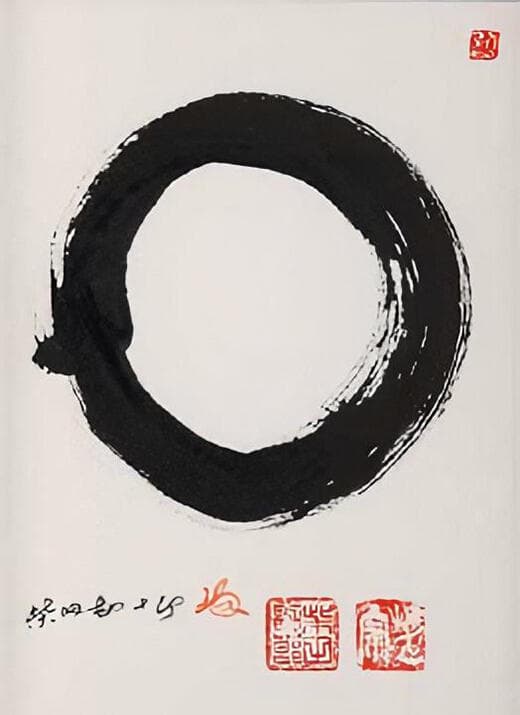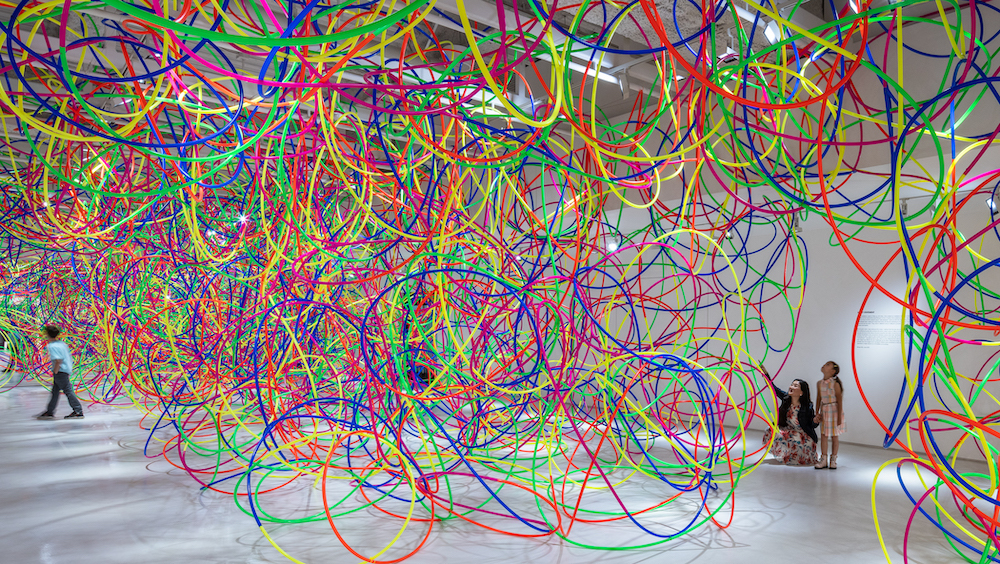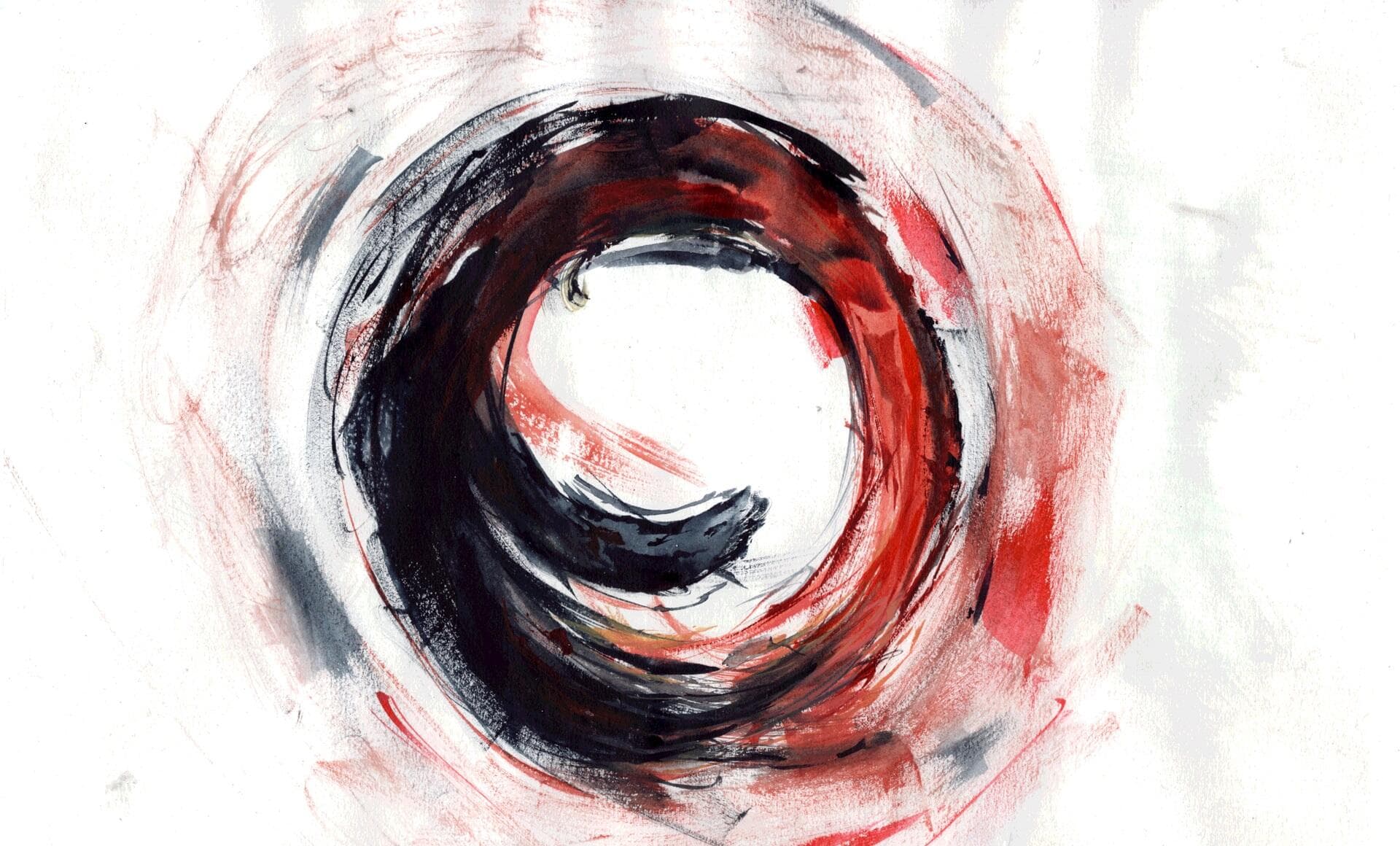The circle symbol or Enso is popular in Zen Buddhism, but what does it signify or mean? It’s both intriguing and yet confusing, just like Zen Buddhism.

Emptiness
When we look at an Enso, we think of a circle, but we often forget it is an empty circle. Emptiness or 虚無 Kyomu in Japanese is an essential part of Buddhist thought.
All things are empty of intrinsic existence is what Buddhism teaches (Sunyata in Sanskrit). There is no fixed separate reality of anything, all things change.
Like word, the Enso points to Emptiness but is it not Emptiness itself. Like a finger that points to the moon, but it’s not the moon itself. It’s the same as the Kanziwa illusion; the pac-man shapes give rise to a triangle, but they are not the triangle you see.
The same is with the circle; the hole in the centre is not drawn, but it is there, but we forget is there. The circle is like the map the circumscribes an empty territory.
It’s the use of empty space, (in Japanese called 間 or Ma), to show meaning. Think of an empty picture frame on a wall. The Emptiness is noticed because of the frame. The Enso is like a frame.

Duality
What we see in the Enso is a duality, that also a unity. Just as an artist who uses contrast to bring attention. Using a black background to make an object seem brighter. Here form is used to bring attention to the Emptiness.
It is a circle; a circle is a form; it has a name, a label. What matters is the formlessness inside. So to highlight the Emptiness, the formlessness, we need a form. It shows that the Enso and Buddhism is pointing to a paradox as the heart of existence.
Emptiness and form always go together.
As it says n the heart Sutra, a major text in Buddhist Mahayana.
Form it emptiness Emptiness is form
There’s a polarity here, each dependant on the other, like two sides of a coin. You can’t have form without formlessness, and vice versa, Nirvana without Samsara.
You need shallow to have deep. You need deep to have shallow. You need a Subconscious to have a Consciousness. You need up to have down.

In RECONNECTING A Vision of Unity by Kengo Kito the installation is a room filled with empty tubes, hula hoops. Each tube is empty and each hoop or circle contain emptiness. So it can be argued the room is full of Emptiness.
Would you notice the Emptiness if the circles, the hoops, or a frame was not there?
Equilibrium
They’re also the simplicity of the circle. It reminds me of a bubble floating in the air. The bubble is self-organising, that is: it shapes itself into the sphere. In a bubble, the surface tension is equal all over, just like a drop of water. So there is stability, in this shape.
It suggests a another important Buddhist notion, finding that equanimity and equilibrium in life.
Minimalism
Speaking as an artist, there’s a simplicity in the Enso; at its most basic, it is just black ink in a single stroke. Yet what it conveys is complex and challenging.
Using just what is necessary to convey the intent is a minimalistic approach characteristic of Zen and Japanese culture. It means living life with what you need and nothing superfluous or unnecessary.
It’s not about having nothing, but having enough, so what you do have matters more.
Discipline
To create an Enso well requires it be painted in one stroke. This is not easy to get right, such hand control requires discipline. I’ve heard some monks use the Enso as a practice to achieve the one stroke effortlessly, spontaneously.
In training a craft like art there has to be a discipline to advance skill towards mastery. This discipline also involves its opposite: freedom. One leads to the other. With building skills, you become more confident and more willing to experiment. Liberated from constraint and convention, another paradox.
Having discipline is to have boundaries, but those boundaries create freedom.
Unity
As I said above, the practice aims to make the work effortless, to unify the art and the artist. So the Enso is then made of a single brushstroke. According to the sōsho (草書) style of Japanese calligraphy, the brushstroke is incredibly swift but decisive. Once drawn, one does not change it.
It shows the character and temperament of its creator and the context of its creation in a brief, continuous period. Such effortless action can only be done with self-consciousness or worry over how it will turn out. Like walking or talking, we can do these effortlessly. Creating an Enso means letting go of your Self and just acting; the duality of the doer and done of Subject and Object is lost.

